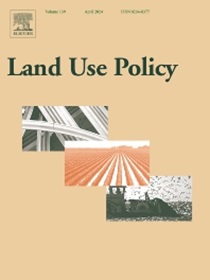解读巴西的做法:森林和景观恢复中社会创新的政策和治理差距
IF 6
1区 社会学
Q1 ENVIRONMENTAL STUDIES
引用次数: 0
摘要
社会创新-森林和景观恢复(SI-FLR)描述了社会创新(SI)推动森林和景观恢复(FLR),改善当地生计和为人们提供自然贡献的过程。本文揭示了阻碍巴西SI-FLR方法的政策差距,并结合巴西国情和国际最佳实践和经验,提出了利用其进步的建议。通过SI-FLR框架的五个概念桥梁,分析了巴西2022年生效的政策文件。应用演绎方法和文本挖掘技术,确定了91个支持si - flr的政策工具,并映射了支配它们的治理结构。出现了四个主要差距:(1)缺乏环境议程的政治意愿;(2)政治协调性差,导致地图治理结构碎片化;(3)景观治理方法缺失,反映了这些结构、修复活动和相关价值链之间的脱节;(4)创新政策中的公民科学差距,突出表明促进公共研究和创新机构与地方社区合作以应对地方社会挑战的工具不足。最后,我们提出了两项战略建议:(1)构建国家景观恢复治理体系,致力于改善政策协调和景观治理;(2)开发一种监管工具,将公民科学引入研究和创新政策,增加合作伙伴关系,创新政策工具,鼓励社会生态创新者。这些建议是在巴西FLR工作中利用科学科学的第一步,并可能激励其他国家扩大社会创新者在制定基于自然的解决方案方面的作用。本文章由计算机程序翻译,如有差异,请以英文原文为准。
Unravelling Brazil's approach: Policy and governance gaps for social innovation in forest and landscape restoration
Social Innovative - Forest and Landscape Restoration (SI-FLR) describes a process in which social innovation (SI) drives forest and landscape restoration (FLR), improving local livelihoods and delivering nature's contributions to people. This paper reveals policy gaps hindering SI-FLR approach in Brazil and offers recommendations to leverage its advancement, incorporating insights from the Brazilian context and international best practices and experiences. Brazilian policy documents in force in 2022 were analysed through the lens of five conceptual bridges of the SI-FLR framework. Applying a deductive approach and text-mining techniques, 91 SI-FLR-enabling policy instruments were identified, and the governance structures ruling them were mapped. Four major gaps emerged: (1) a lack of political will for the environmental agenda; (2) poor political coordination, resulting from the fragmentation of the mapped governance structures; (3) a missing landscape governance approach, reflecting the disconnection between these structures, restoration activities and value chains associated; and (4) a citizen science gap in innovation policy, highlighting the insufficiency of instruments promoting collaboration between public research and innovation institutions and local communities to address local social challenges. We conclude with two strategic recommendations: (1) structuring a National Landscape Restoration Governance System dedicated to improving policy coordination and landscape governance and (2) developing a regulatory instrument bringing citizen science to the research and innovation policy, increasing collaborative partnerships, innovation policy instruments and encouraging socioecological innovators. These recommendations represent a first step towards leveraging SI in the Brazilian FLR effort and may inspire other countries to expand the role of social innovators in developing nature-based solutions.
求助全文
通过发布文献求助,成功后即可免费获取论文全文。
去求助
来源期刊

Land Use Policy
ENVIRONMENTAL STUDIES-
CiteScore
13.70
自引率
8.50%
发文量
553
期刊介绍:
Land Use Policy is an international and interdisciplinary journal concerned with the social, economic, political, legal, physical and planning aspects of urban and rural land use.
Land Use Policy examines issues in geography, agriculture, forestry, irrigation, environmental conservation, housing, urban development and transport in both developed and developing countries through major refereed articles and shorter viewpoint pieces.
 求助内容:
求助内容: 应助结果提醒方式:
应助结果提醒方式:


